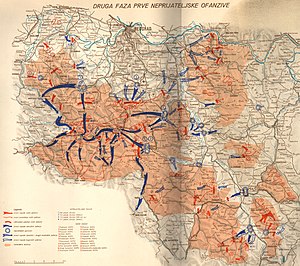First anti-Partisan offensive
September 27:
September 27:
November 1 on:
November 1 on:
November 1 on:
Operation Uzice was the first major counter-insurgency operation by the German Wehrmacht on the occupied territory of the Kingdom of Yugoslavia during World War II. The operation was directed against the Užice Republic, the first of several "free territories" liberated by the Yugoslav Partisans. It was named after the town of Užice, and is associated with the First Enemy Offensive (Serbo-Croatian: Prva neprijateljska ofenziva/ofanziva) in Yugoslavian historiography. The security forces of the German-installed puppet regime of Milan Nedić also participated in the offensive.
After the offensive commenced on 20 September 1941, the Partisans initially received assistance from local Chetnik formations in opposing the Germans, but after weeks of disagreement and low-level conflict between the two insurgent factions about how the resistance should proceed, the Chetniks launched an attack on the Partisans in the towns of Užice and Požega on November 1 which resulted in the Chetniks being repulsed. The Partisans then counter-attacked decisively, but by early December had been driven from liberated area by the German and Serb collaborationist offensive.
On July 7, 1941, while Chetnik forces were still inactive, Josip Broz Tito and the Partisans staged a large-scale uprising in the region between Šabac and Užice, in the Krupanj area of northwest Serbia One Žikica Jovanović Španac shot the first bullet of the campaign on 7 July 1941 – marking the start of armed resistance in occupied Yugoslavia. The uprising was successful and secured a defensible, self-sustained, independent region, the first of many "free territories" to be established by the Partisans during the course of the war, and was commonly called the "Užice Republic". Almost immediately, the Germans made a concerted effort to find out whether the Chetniks ("nationalists") supported the uprising, as they felt that only with nationalist support could it acquire a mass character. On August 14 the Headquarters of the Military Commander in Serbia reported to the OKW that the Partisan forces thus far enjoy no support from the nationalists. Despite this, the German military forces in the region were deemed insufficient to quell the uprising, which by August 27 had become "more acute" and was rapidly spreading. Because of this, and since no reinforcements could be expected, the German authorities decided to rely on enlarging Serbian auxiliary forces in order for the "Serbs themselves to crush the communist activity".
...
Wikipedia

